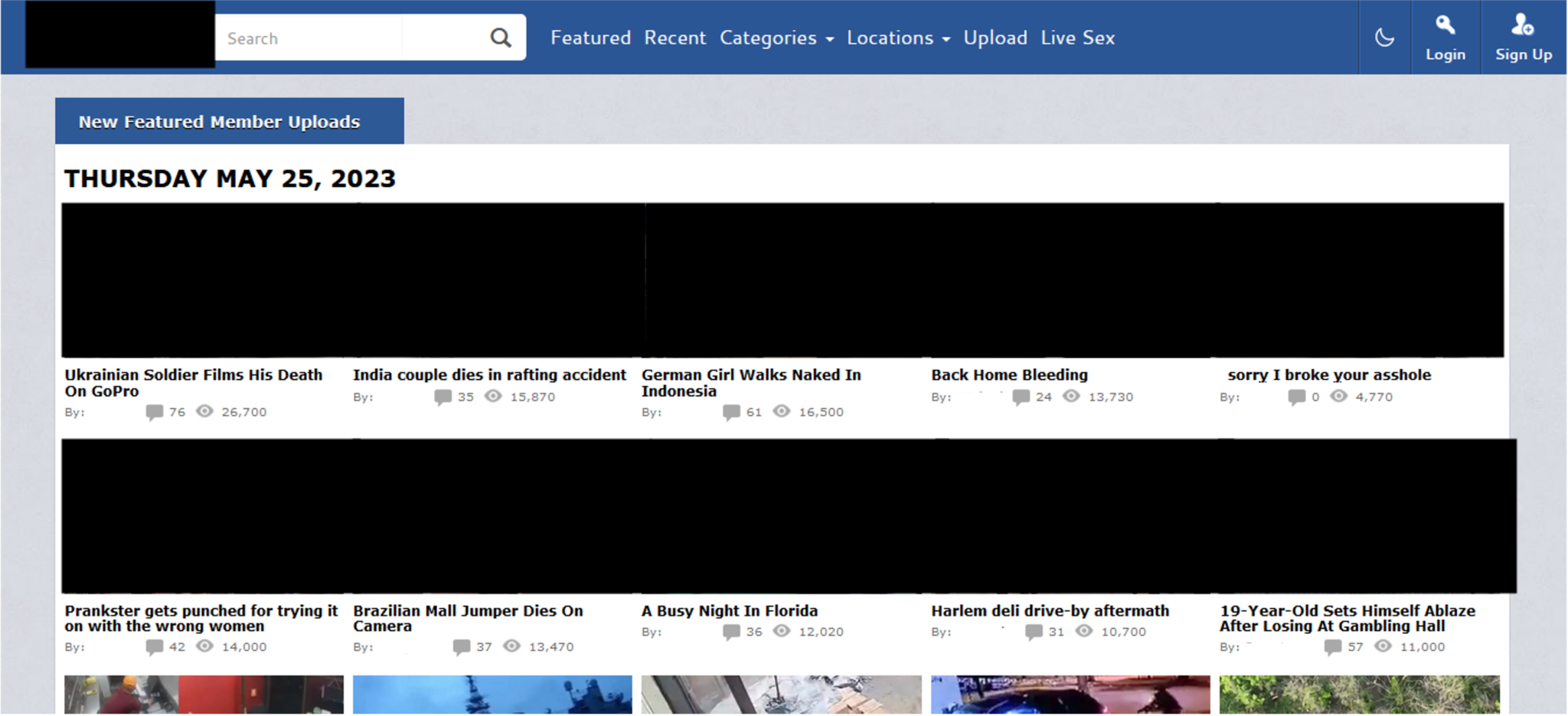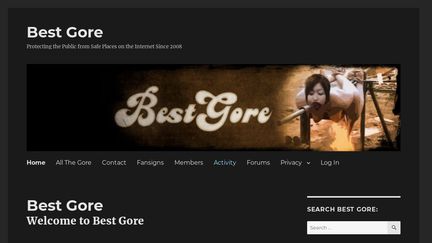Understanding Gore Sites: A Deep Dive Into The Unfiltered Reality Of The Web
In the vast and often unregulated expanse of the internet, there exist corners that host content far removed from the mainstream. Among these are "gore sites," platforms dedicated to showcasing graphic, disturbing, and often violent real-world events. These websites present an unfiltered, raw depiction of life and death, pushing the boundaries of what many consider acceptable online content. For the uninitiated, understanding what these sites are, what they contain, and why they exist can be a jarring, yet important, exploration into the darker side of digital information.
What Exactly Are Gore Sites?
At their core, gore sites are online platforms primarily designed to display explicit and graphic content, often involving violence, death, and extreme human suffering. Unlike fictional horror, the material found on these sites is purported to be real, captured from various incidents across the globe. They are often categorized as "shock sites" because their primary intent is to be offensive or disturbing to viewers. While some shock sites might incorporate elements of humor or even evoke sexual arousal in certain viewers, gore sites typically focus on the raw, unadulterated shock of violence.
One prominent example, Livegore, describes itself as a "reality news website which reports on real life events which are of the interest to the public." This framing suggests an attempt to legitimize their content as a form of extreme journalism, offering an unfiltered look at global incidents that traditional media might shy away from due to their graphic nature. However, the line between reporting and sensationalism often blurs significantly on these platforms.
The Disturbing Panorama of Content
The content found on gore sites is consistently graphic and intentionally shocking. It's a stark portrayal of human brutality and misfortune, often presented without context or censorship.
True Crime and Real-Life Horrors
Many gore sites feature extensive collections of "true crime" videos. These are often clips "taken from across the world," depicting the aftermath or even the act of violent crimes. The platforms aim to provide a raw, unedited glimpse into the criminal underworld and its devastating consequences. This can include anything from street brawls escalating to fatalities, to more organized acts of violence.
Extreme Violence and Graphic Depictions
The categories of content available on these sites leave little to the imagination. Viewers can "browse categories like executions, beheading, torture, etc." This explicit listing highlights the extreme nature of the material. Other common themes include:
- Dismemberment: Videos and photos showing bodies or body parts dismembered.
- War and Conflict: Footage from active war zones, showcasing the brutal realities of combat, including injuries and fatalities.
- Criminal and Terror Acts: Videos depicting acts of terror, cartel violence, or other organized criminal activities. For instance, some sites might feature "execution of victims by gangs," or even confessions from individuals involved in criminal enterprises, such as the reported confession of a captive overseeing CJNG operations involved in fuel theft.
- Accidents and Tragedies: While less common than intentional violence, severe accidents with graphic outcomes can also be found. An example cited is an "upset crowd of Haitians caves in and crushes a guy's skull and sets his body on fire," illustrating the raw, chaotic violence that can occur in real-world scenarios.
The platforms often claim to show "reality since 2020" or "reality since 2022," emphasizing their commitment to displaying events as they truly happened, without sanitization. As one site puts it, "Gore isn't funny, to tell the truth, reality."
The "Reality" Aspect
A recurring theme among these sites is their assertion of showing "unfiltered reality of life and death." This is their justification for presenting content that most mainstream media would deem too graphic for public consumption. They position themselves as a window into the raw, often brutal, aspects of human existence that are typically hidden from view. This commitment to showing "the most brutal and extreme gore videos in the world" is a defining characteristic.
Navigating the Digital Underbelly: Specific Platforms
Several websites have become notorious for hosting graphic content, each with its own focus and community.
Livegore
As mentioned, Livegore positions itself as a "reality news website." It's known for its extensive collection of "videos relating to true crime that have been taken from across the world." Due to the "graphic nature of materials found on Livegore," access is strictly "restricted to adults only (18+)," with a clear warning: "!!please leave this website if you under that age!!"
Deep Gore Tube
This platform is specifically highlighted for hosting "the most brutal execution videos in the world." It features a "pure gore category" dedicated to the most extreme content. Users can "watch war, criminal, terror, clandestine" videos, indicating a broad range of highly sensitive material.
Xgore.net
Xgore.net is another site focused on "gore content, latest murder photos and videos." It explicitly lists content like "beheading, dismemberment, execution of victims by gangs," reinforcing the extreme nature of its offerings. Like others, it claims to "show you reality since 2022."
Goresee
Described as a "hub for gore videos," Goresee likely acts as an aggregator or repository for such content. Its mention of matching queries against "video names or descriptions, channel names" suggests a search functionality to help users find specific types of graphic material.
Accessing the Unseen: Age Restrictions and Membership
Given the extremely graphic nature of their content, gore sites universally implement strict age restrictions. Access is almost always limited to individuals "18+" years of age. This is not merely a formality; the content is genuinely disturbing and can have severe psychological impacts on unprepared or underage viewers. The explicit warning, "!!please leave this website if you under that age!!", underscores the seriousness of this restriction.
Beyond age verification, some platforms also employ membership systems. For instance, certain areas might only be accessible to "Members in TT," who "will only be allowed to see this area when they come to the site." Furthermore, community interactions, such as posts, may undergo moderation: "all your posts here will be go into moderation before they are approved." This suggests an attempt, however minimal, to manage the content flow and user interactions, perhaps to prevent illegal activities or even more extreme unsolicited content.
The Technical Backbone: How These Sites Operate
Hosting and distributing such graphic content on a large scale requires specific technical infrastructure, especially given the likelihood of being deplatformed by mainstream hosting providers. Some platforms leverage decentralized technologies to maintain their presence. For example, the mention of "Peertube, a federated (activitypub) video streaming platform using p2p (bittorrent) directly in the web browser with webtorrent and angular," indicates that some sites might utilize peer-to-peer streaming to reduce reliance on central servers and make content harder to remove. This technology allows users to stream videos directly from other users, creating a more resilient and censorship-resistant network for distributing content.
The Profound Impact and Ethical Quandaries
The content on gore sites is not merely visually disturbing; it can have profound psychological effects on viewers. Exposure to such raw and extreme violence can lead to desensitization, anxiety, trauma, and a distorted perception of reality. The explicit statement that "many gore videos that will make you upset" is an understatement for most individuals. For some, the content is intended to be offensive, while for a very small minority, it might evoke "sexual arousal," highlighting the complex and often troubling psychological responses to extreme stimuli.
Ethically, gore sites raise numerous questions. While proponents might argue for freedom of information and the right to witness "unfiltered reality," critics point to the potential for glorifying violence, promoting harmful ideologies, and the severe psychological harm to viewers. The line between documenting reality and exploiting human suffering becomes incredibly blurred on these platforms. They exist in a moral gray area, challenging societal norms about what information should be publicly accessible and how it should be consumed.
Navigating the Darker Corners of the Web
Gore sites represent a controversial and disturbing segment of the internet, dedicated to showcasing the most brutal and unfiltered aspects of real-world violence and death. From "reality news" to explicit "executions, beheading, and torture," these platforms provide a stark and often traumatizing glimpse into human suffering. With strict age restrictions and sometimes membership requirements, they cater to a niche audience seeking to witness what they perceive as "unfiltered reality." While leveraging technologies like Peertube to maintain their presence, the profound psychological impact and ethical dilemmas posed by such content remain a significant concern. They serve as a stark reminder of the internet's capacity to host content that challenges our understanding of acceptable boundaries and the human psyche.

2024 Gore Sites - Sharl Maggie

Mehdiriko Shockgorecom

12 beste Websiten wie BestGore für schockierende Videos | Leawo